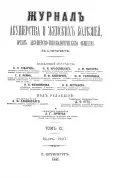To the anatomy and treatment of ectopic pregnancy
- Authors: Maslovsky V.O.1
-
Affiliations:
- Military Medical Academy
- Issue: Vol 11, No 9 (1897)
- Pages: 928-943
- Section: Articles
- URL: https://journals.rcsi.science/jowd/article/view/50783
- DOI: https://doi.org/10.17816/JOWD119928-943
- ID: 50783
Cite item
Full Text
Abstract
Regarding the vessels, my research yielded results similar to those obtained by other researchers. The vessels of the cellular layer are of particular interest, in particular those of them that, having a large caliber, have only an endothelial membrane (capillaries) or even lack any membrane (Blutlacnnen ѵ. Tussenbroek). The opinions of the authors differ as to the origin of these vessels from arteries or veins, due to the loss of the membranes and their expansion. Dobbert recognizes their origin in arteries, similar to the pregnant uterus and tube. Tussenbroek found that the arteries in the decidua retained their structure, and their branches, without loss of muscle membrane and expansion, came close to the surface. Therefore, she considers the veins to be the source of these vessels. As for my case, I found in the cell layer, in addition to capillaries and blood cavities without a trace of membranes, also branches of arteries with an extremely thin connective tissue membrane, which was especially striking when compared with the membranes of the arteries of the glandular layer. Therefore, I am inclined to recognize the origin of these blood vessels from the branches of the arteries, due to the loss of the membranes and their successive expansion. Thus, we find here a process analogous to that which occurs in decidua serotina during normal pregnancy, as proven by Waldeyer's work, Bohr's, Hofteier's, Gottschalk's and others. The presence of such blood cavities, devoid of their own wall, is the second characteristic feature of deciduae uteriuae during ectopic pregnancy.
Full Text
##article.viewOnOriginalSite##About the authors
V. O. Maslovsky
Military Medical Academy
Author for correspondence.
Email: info@eco-vector.com
Privat-docent
Russian FederationReferences
Supplementary files







